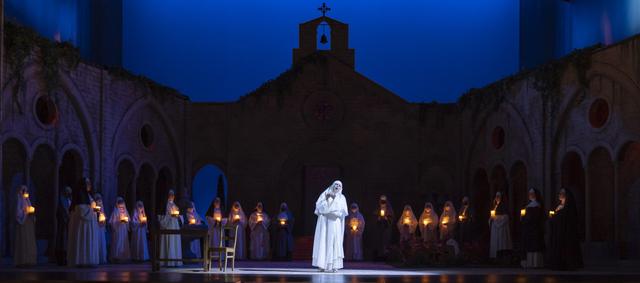Olyrix Mese Mariano & Suor Angelica in Liège: chills and tears Olyrix<
Mese Mariano, rarity signed Umberto Giordano (mainly known for its Andrea Chénier), with strong pages and the great finesse of writing, thus takes place in a monastery located in the heart of the Neapolitan city whose landscapes are displayed in the background Plan: The Citadine Carmela thus brings the outside world to which it belongs. Conversely, the cloister where Suor Angelica is held, the second installment of the Puccini triptych, reinforces the feeling of imprisonment of this character who took the veil against his will, by penance. A fourth wall even descends from the hangers, physically materializing this confinement. The rich costumes signed Teresa Acone situated the action at the time of the creation of these opus (respectively 1910 and 1918), only the masks worn by the choristers and mastery impose their anachronism. The scenic direction is fine: the poignant dramas can thus unroll their relentless mechanism. These opus are in fact alike, in a mirror effect: two mothers face the death of their child from which they are separated. In one case, the child is locked up and the mother is not informed of the death (pious lie that questions), the right to see him simply refused to him. In the other, it is the mother who is isolated, and who learns the terrible news by the odious silence following her desperate question: "He died? ».
This feeling of confinement is found in music: in fact, the Oksana Lyniv chief takes place in a plexiglass cage separating it, for health reasons this time, musicians from the Royal Opera OrchestraWallonia.The young chef seems to draw in the depths of herself the emotions that the orchestra distills, singing with all her soul with the singers.The phalanx produces a tender and lyrical sound, snatching chills and tears from the public.The children of the mastery of the Royal Opera are touching and very fair.

Serena Farnocchia has the heavy task of carrying the main roles of the two opus: Carmela and sister Angelique.His released voice with dark reflections widens in large lyrical impulses or flies away in sharp treble.His vibrato is intense, bearer of the distress of his characters.The breath is long, bearing eloquent lines.Its fragility is physically embodied, in its posture and gestic.
Violeta Urmana relies on a bubbling voice, with a warm and hard stamp, with a stirring vibrato.She is also touching in a superior mother in the first opus that an intertable in princess in the second.The voice first destabilized, she arrives over her only scene from the second part to sit on her serious sovereigns an aristocratic hardness and a sententious phrasing.
@Kindwolf_ It's Already White! I Want Rough Stone Though Instatead of this tile
— Katie Belle Thu Jul 22 18:44:36 +0000 2021
Sarah Laulan has a well -projected voice, with a round vibrato.His dark and fluffy sitting on the bas-medium offers her voice the warmth that Sister Pazienza offers Carmela or the authority of the zealous sister.The Countess of Aurore Bureau deploys, in her sumptuous dress, a voice of velvet, red, firm, well stood and in the voluble vibrato.As a mistress of novices, his voice shows more firmness by a higher placement, while his stamp is blackening.In sister Cristina, Julie Bailly paints a human character, with a velvety, deep voice, supported on a slight vibrato.Conversely, she metamorphoses into abbess to camp a heartless woman.His voice, then flattened, remains rich in stamp.
As a sister Celeste then Sister Géneviève, Morgane Heyse brings her singing and satin voice, to the fruity stamp and supported on the treble.His vibrato is light, his phrasing voluntary, the breath long.Natacha Kowalski is sister Marie then a sister's sister.His voice is fine but well seated in the bass, supported on a lively phrasing.
The only man in the distribution, Patrick Delcour in Don Fabiano exhibits a firm, well seated voice, developing a worked diction.The distribution is supplemented by Alexia Saffery (novice) with her pinch -stricken voice, Beatrix Papp (nurse) with a well -expressed and deep voice, dug by her vibrato, and Réjane Soldano (sister Dolcina), with a high voice.
Before dying under the effect of the poison, sister Angélique appeals to the Virgin Mary to be saved from damnation.This appears to him, accompanied by the lost son, a masked little angel bringing the redemption.The 200 spectators (this first evening is the last date before the lifting of this gauge in Belgium) testify as much as they can of the emotion provided by these two works.For those who could not go there, production can be discovered in mid-February, streaming on ôlyrix.


 Tags:
Tags: Prev
Prev







